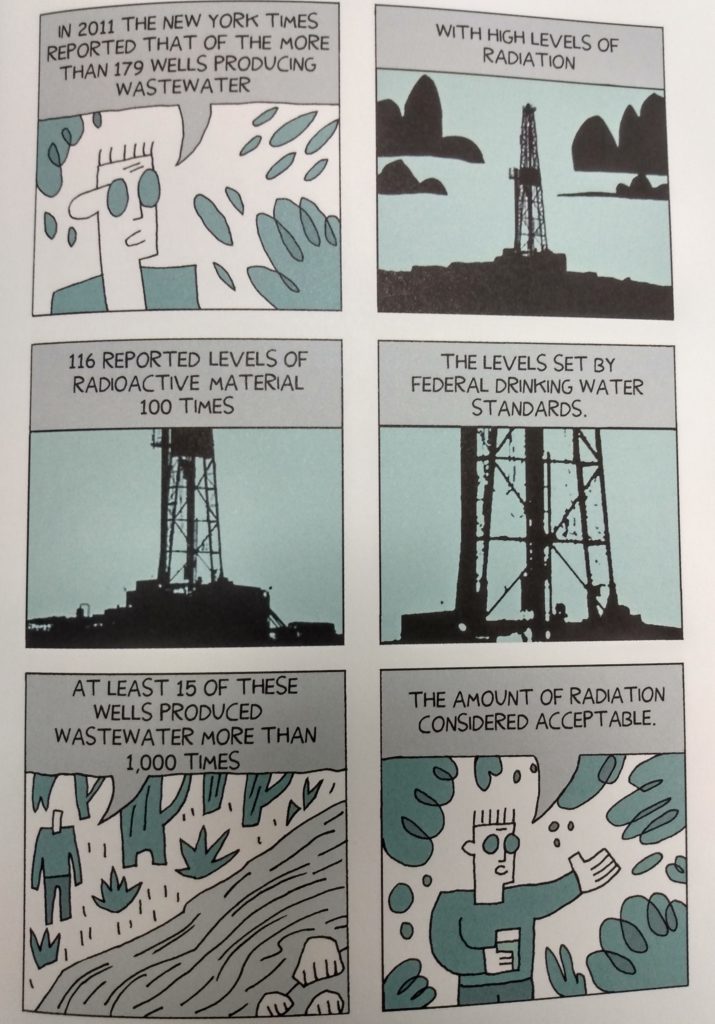“For decades environmental protections have been rolled back at the behest of the oil and gas industry, an industry now free to give vast amounts of campaign contributions to its chosen politicians whose loyalty is to their wealthy donors first, rather than the electorate” — Narrator, How to Fake a Moon Landing, p. 131-2.
| Creator(s) | Darryl Cunningham (author), Andrew C. Revkin (introduction) |
| Publisher | Abrams ComicArt |
| Publication Date | 2013 |
| Genre | Educational, Nonfiction |
| Environmental Themes and Issues | Anthropomorphism, Climate Change, Coral Reef Bleaching, Drought, Educational Nature Facts, Extinction, Flood, Fracking, Fuel Extraction or Shortages, Melting Ice, Pollution, Recycling, Water Conservation |
| Protagonist’s Identity | White male narrator |
| Protagonist’s Level of Environmental Agency | Level 4: Considerable Environmental Agency without Activism |
| Target Audience | Young Adult |
| Settings | Various settings, including Canada and the United States (fracking), the Arctic (climate change), and outer space (the moon hoax) |

Environmental Themes
How to Fake a Moon Landing: Exposing the Myths of Science Denialism examines eight contemporary hot-button controversies: the moon landing, homeopathy, chiropractic, vaccinations and autism, evolution, fracking, climate change, and science denial. Creator Darryl Cunningham provides a critical, scientifically-based analysis of these topics. The visual narrative blends conventional comics panels, diagrams, photographs, and text to give an overview of each controversy and debunk disinformation about the subjects.

For instance, in the chapter on fracking, the white male narrator educates readers about the process of hydraulic fracturing, or “fracking.” He highlights the negative impact that fracking has on the environment, such as chemical contamination of groundwater and the discharge of diluted toxic waste into rivers. The narrator also points out the disinformation spread by the gas industry, which promotes fracking as safe and contends that there has been no evidence of chemical contamination caused by fracking operations. The narrator concludes the chapter by spotlighting the ways that politicians have enabled unethical fracking practices. For example, Dick Cheney, a former chief executive of the energy corporation Halliburton, created a provision of the 2005 Federal Energy Bill that stripped the Environmental Protection Agency of the power to regulate fracking. The narrator criticizes this entanglement of politics with energy companies, stating, “That there should be such naked interference in the political process by big business is clearly wrong. It is science, unaffected by political bias or emotion, that should decide whether fracking is environmentally safe or not” (Cunningham 133).

Similarly, in the climate change chapter, the narrator–aided by a talking penguin–presents the scientific argument for human-driven climate change. The comic also discusses reasons why opponents deny the existence of climate change and refutes these arguments. The penguin notes that the billionaire Koch brothers and other wealthy business owners with stakes in the fossil fuel industry have opposed climate change for ideological reasons, remarking, “The oil and coal industries have a lot at stake. If the answer to the problem of climate change involves phasing out fossil fuels, then a different set of people will be making money. It’s no wonder that they’re fighting tooth and nail against it” (Cunningham 149). The chapter concludes by highlighting various environmental issues impacted by climate change, such as coastal flooding, coral bleaching, drought, and mass extinctions. The penguin encourages readers to take these problems seriously, saying, “The science predicts that these events could happen. Let’s not leave it to the super-rich to decide who lives and who dies” (Cunningham 153). By educating readers about the financial and political motives underlying many popular conspiracies, the comic exposes the roots of disinformation and promotes science-based approaches to environmental issues.
Paratexts
The comic includes a two-page introduction written by Andrew Revkin that discusses the importance of demystification and critical thinking. While Revkin praises Cunningham for combatting disinformation, he also encourages readers to engage in their research about the topics found in the book, writing, “In some parts of this book, to my eye, Cunningham’s deep passion for defrocking falsehoods has carried him too far… But don’t take my word for it. Dig in. Find out how to use Google Scholar to probe basic research. Read a scientific paper. Talk to a scientist! They’re not hard to find, and most are eager to help the public understand their work” (Cunningham 5). By suggesting potential avenues for readers to participate in research, Revkin empowers the audience to build on what they learn from the comic by engaging in critical inquiry.
Additionally, Cunningham writes a two-page preface that describes how the author developed an interest in critical thinking and science. He writes, “This book is pro-science and pro-critical thinking… Science isn’t a matter of faith or just another point of view. Good science is testable, reproducible, and stands the test of time. What doesn’t work in science falls away, and what remains is the truth” (Cunningham 7). Like the introduction, this paratext encourages readers to take a hard look at their own beliefs and seek out knowledge.
The backmatter also includes a bibliography that lists the sources that informed the creation of each chapter.



